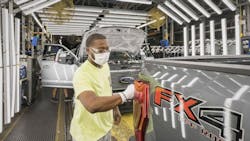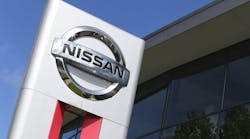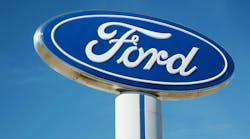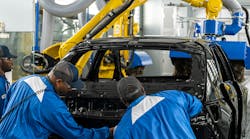Ford Vice Chair: Why Automotive OEMs Haven’t Consolidated
The automotive sector is going through wrenching changes as its players invest in an electric future. Some upstart ventures that not long ago promised radical new products have fallen by the wayside while legacy manufacturers are walking the tightrope of preparing for an EV-dominated market while safeguarding the ability of their internal-combustion offerings to generate lots of cash.
Those rapidly evolving, capital-intensive dynamics should have primed the pump for a wave of mergers and acquisitions, right? Yet, with a few small exceptions and some washouts such as Arrival and Fisker, that consolidation wave hasn’t materialized.
Speaking recently at Bernstein’s 41st Annual Strategic Decisions Conference, Ford Motor Co. Vice Chair John Lawler talked with Bernstein analyst Daniel Roeska about some of the reasons why and laid out his thinking as to what might happen going forward. Here is an excerpt from that conversation, lightly edited for brevity and clarity.
Roeska: Why hasn’t [consolidation] already happened? And what’s been preventing the industry from consolidating more?
Lawler: If you look at any other industry with this makeup, they would have consolidated quite a while ago. I think there’s a lot of factors that limit that consolidation. It’s complex, it’s capital-intensive. You have a lot of players that you need to satisfy, from dealers to unions. A lot of the companies have a lot of issues that need to be worked through. You have antitrust concerns in certain segments of the business that would limit that ability to consolidate.
The way we’re thinking about it is [that] consolidation probability is low. I don’t think you’re going to see a lot of consolidation—pure consolidation. I think some companies aren’t going to make it. I think that’s just the nature of how things are going to shake out.
But what I do think there’s an opportunity for is partnerships and alliances, where we can work together on the investment that has to take place on many of these developing areas and that we all don’t have to do it on our own. We can do that in partnership. And that would [improve] capital efficiency. It would increase speed to market. And it would allow us then to bring some of this forward, from an industry standpoint, when it comes to electrical architectures, software-defined vehicles, even platform sharing.
Roeska: There are very few examples in global autos where there’s been a big alliance and a big partnership. What do you think you need to inject into those discussions to come to different outcomes?
Lawler: We’ve seen some that have worked well and we’ve seen some that have died over time. And […] the partnerships or alliances that have gone away over time—it’s not necessarily a bad thing. Some of them are more transactional. Some of them are more long-lasting. I mean, we’ve had a partnership with Otosan for over 25 years. That’s been really strong. So, I think we need to look at it with the reality of, “Is this short-term? Is this long-term? Are we complementary in different areas around the world?”
The other thing is it’s just going to be the necessity to allow us to get done what we need to get done. With the speed that’s changing this industry, you’re not going to be able to do it all on your own at the pace that it needs to take place and the capital that’s going to be required. One of the fundamental shifts that’s happened in the industry [is that], if you go back and look at the amount of capital that the Western OEMs have […] taken out of China over the last 10 to 12 years, it’s $80-plus billion. That’s evaporating. That’s down, what, 40% to 50% over the last three years. That capital funded a lot of the investment that’s happened in the industry.
With that being gone, everybody is not going to be able to do this on their own. There are going to be these forcing factors that are going to push us into figuring out how we continue to stay competitive. And those that don’t are going to be the ones that are going to have a hard time keeping up.
Roeska: What are some of the ideas, either horizontal or vertically, where you’d say that could be something you’d be interested in?
I think ICE powertrains over time are going to need to consolidate and they’re not going to be differentiated.
- John Lawler
Lawler: It could be […] things that don’t differentiate you versus your competitors. And that could be anywhere from sharing componentry motors on battery electric vehicles. I think batteries is a good example where many of us have set up joint ventures and partnerships […] Those are going to commoditize over time. I don’t think they’re going to be differentiated.
I think ICE powertrains over time are going to need to consolidate and they’re not going to be differentiated. I don’t think that consumers really think about powertrains the way they did 30 years ago, where it defined what a vehicle was—the horsepower, the displacement, the torque and everything about the vehicle. I think a lot of that is gone.
So does everybody need to develop the next four-cylinder and six-cylinder? When it comes to technologies from a standpoint of multi-energy, does everybody need to develop that? Or are there going to be a few that have that, where you’d partner and you’d leverage their capacity?
It could come down to where you have platforms […] and then you’re just putting a top hat on somebody else’s platform because there are scale opportunities. It could come down to certain emerging players wanting to grow globally [who] don’t invest in their own manufacturing facilities and you share a platform in those facilities.
So I think […] a lot of change is going to happen over time relative to how we think about how precious things are that we’ve felt were precious in the past. I think what it’s going to come down to is the brand and your relationship with your customers and then the services and the experiences that you give them. Those are going to be the differentiating elements going forward versus the hardware.
About the Author
Geert De Lombaerde
Senior Editor
A native of Belgium, Geert De Lombaerde has been in business journalism since the mid-1990s and writes about public companies, markets and economic trends for Endeavor Business Media publications, focusing on IndustryWeek, FleetOwner, Oil & Gas Journal, T&D World and Healthcare Innovation. He also curates the twice-monthly Market Moves Strategy newsletter that showcases Endeavor stories on strategy, leadership and investment and contributes to other Market Moves newsletters.
With a degree in journalism from the University of Missouri, he began his reporting career at the Business Courier in Cincinnati in 1997, initially covering retail and the courts before shifting to banking, insurance and investing. He later was managing editor and editor of the Nashville Business Journal before being named editor of the Nashville Post in early 2008. He led a team that helped grow the Post's online traffic more than fivefold before joining Endeavor in September 2021.






